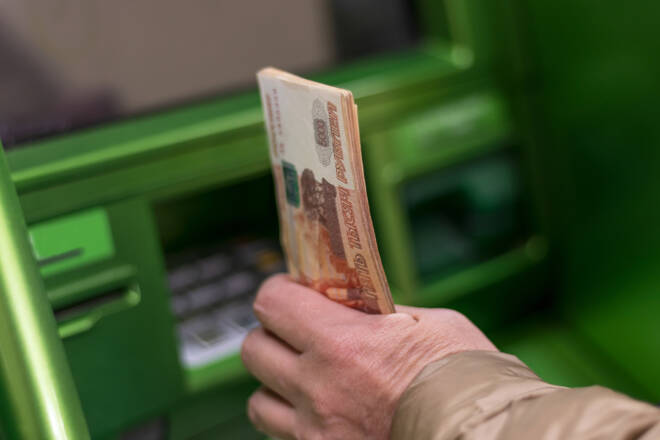Advertisement
Advertisement
Russian Ruble Closes at Two-Month High
Published: Apr 11, 2022, 09:11 GMT+00:00
After Vladimir Putin decided to invade Ukraine, the Russian Ruble (RUB) tumbled quickly, with 1 ruble buying only .7c, due to the uncertainty, international rounds of sanctions on the Russian economy, and Russia’s financial isolation supporting the fall of the currency.
But what President Joe Biden called “rubble” has surprisingly recovered since its low level on March 7th, as the Russian currency is now buying 1.3cat the time of writing, right back where it was.
Investors are wondering why the currency is strengthening while there are still so many uncertainties surrounding the Ukraine-Russia conflict, as many thought the loss of value of the Russian currency would be a rather long-term issue…are we seeing a dead cat bounce? Or is it rather a sustained recovery? How come the RUB is so resilient? Why was the Russian Ruble the top-performing currency last month?
Let’s try to understand the reasons behind the sharp and quick recovery of the Russian currency.
Aggressive capital controls & Central bank actions
As an answer to the international sanctions against Russia, the country took several measures to fight capital flight.
That includes the limitation of money transferred abroad by Russian citizens, the banning of brokers selling securities and other assets held by non-residents, and the mandatory conversion into the Ruble of 80% of the foreign currencies received by all Russian exporters to avoid significant outflows from the Russian financial markets and minimize losses.
Measures are also imposed on foreign-currency Russian bank accounts, as they aren’t allowed to withdraw more than $10,000 in dollars, the rest has to be kept in Rubles.
On February 28, the Russian central bank increased its key interest rate to 20% to support its financial system, providing an incentive to Ruble owners to save money in the local currency rather than to try to convert it into foreign currencies. On April 8, interest rates were lowered to 17%.
These massive capital control rules have somewhat rescued the Russian Ruble by putting a floor under the price, therefore limiting the depreciation of the local currency thanks to fewer Rubles going up for sale.
A steady flow of foreign currency coming into Russia
Despite sanctions to restrict Russia from acquiring foreign currencies like the US Dollar or the Euro, several countries are still buying commodities like oil, natural gas, and coal from Russia because they are very dependent on Russian energy sources.
As these countries are paying Russia in foreign currency, they provide a steady flow of foreign currency, which has eased concerns about Russia becoming insolvent and helped control the Russian fall.
“Unfriendly countries” might have to pay for Russian energy in Rubles
In retaliation for international sanctions after the Ukraine invasion by Russian forces, Putin decided that “unfriendly countries” will have to pay for their gas in Russian Rubles. If he is successful, this decision would force buyers to convert their foreign currencies into the local Ruble, therefore supporting the Ruble.
While the European Commission has asked concerned countries to refuse and stick to the original contracts, Hungary broke ranks with Europe by saying it was prepared to pay its gas in Rubles.
But insisting on payments in Ruble would mean negotiating contracts, which might help buyers exit from Russia altogether. Even if Russia is the world’s largest natural gas producer, and the biggest exporter, there are still other suppliers out there buyers might want to consider buying from. With rising energy prices and worsening relationships between Russia and the West, most countries are considering the need to reduce their dependence on Russian energies, speed up their transition to cleaner energies, and diversify their sources of energy.
Final word
Sanctions need to be adjusted over time in order to be effective, and Russia is quickly adapting to a new balance of capital controls, managed prices, as well as economic and financial self-sufficiency, so it isn’t that surprising that domestic markets are somewhat stabilizing, pushing the Russian ruble higher.
But everything is still shrouded in uncertainty and new potential action against Russia, especially around its energy sector, could significantly impact the Russian economy – and the RUB by extension.
About the Author
Carolane De Palmascontributor
Carolane's work spans a broad range of topics, from macroeconomic trends and trading strategies in FX and cryptocurrencies to sector-specific insights and commentary on trending markets. Her analyses have been featured by brokers and financial media outlets across Europe. Carolane currently serves as a Market Analyst at ActivTrades.
Advertisement
